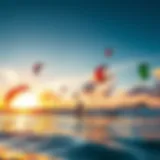Mastering Washington's Wind Map for Kiteboarding Enthusiasts
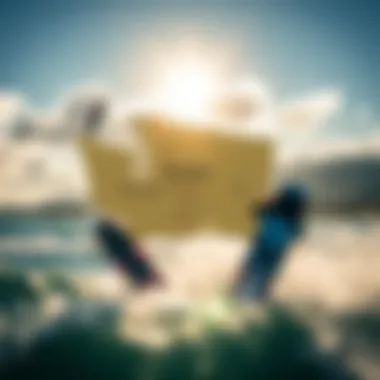
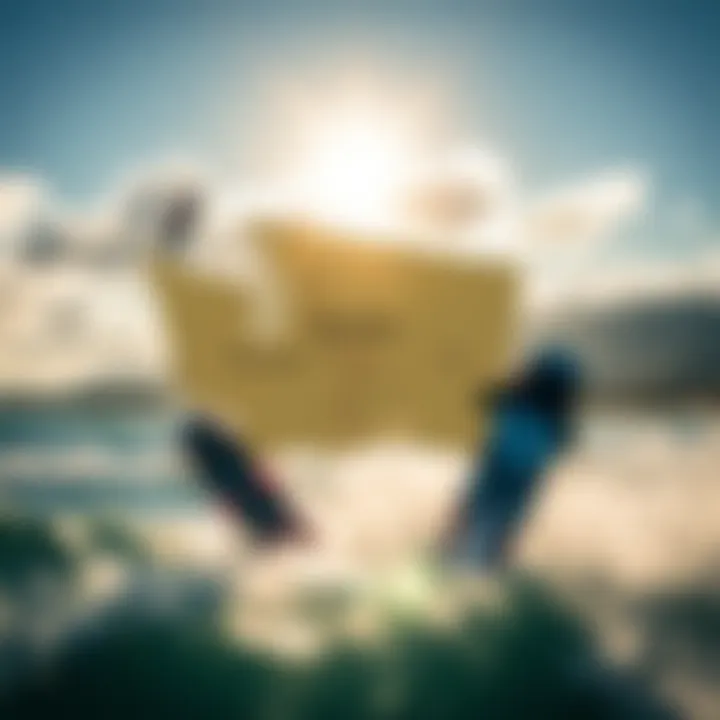
Intro
When adjusting to the exhilarating and sometimes unpredictable world of kiteboarding, being well-acquainted with wind resources can make all the difference between a joyful glide across the water and a day spent combing the shoreline for favorable conditions. Washington’s vast landscape offers kiteboarders a unique blend of areas with diverse wind patterns, each harboring its own set of advantages and challenges. By ignoring these wind dynamics, you’re not just missing out on an increasingly immersive experience; you’re potentially jeopardizing your safety.
In this comprehensive guide, we set out to demystify wind mapping across Washington. Not only do we aim to equip novices with fundamental knowledge, but we also provide advanced kitesurfers with nuanced insights into optimizing their riding strategies. As you navigate through this guide, expect a treasure trove of tips for interpreting wind charts, identifying optimal kiteboarding spots, and fortifying your approach to safety.
"Understanding wind patterns is like reading the ocean’s breath. It speaks volumes about your kiteboarding adventure."
To truly enjoy the thrill of kiteboarding, you need to let the wind guide you. Dive in and uncover how to harness this natural force effectively!
The Significance of Wind Mapping
Wind mapping plays a critical role in not just understanding meteorological patterns but also revolutionizes how enthusiasts approach activities like kiteboarding. For kiteboarders, the symbiosis between wind dynamics and performance cannot be overstated. Wind maps provide a visual representation of the invisible forces that shape the kiteboarding experience, guiding riders to optimal conditions for both enjoyment and safety.
Understanding Wind Patterns
To truly grasp the various wind patterns, one must consider how different geographical factors influence them. Washington State has a variety of topographical features, such as mountains, valleys, and coastlines, all contributing to distinct wind characteristics. For example, winds flowing over the Cascade Mountains can create dramatic changes in speed and direction, leading to both turbulence and opportunities for thrilling rides.
Observing wind patterns can help kiteboarders make informed decisions:
- Consistent Wind Conditions: Some areas may have steady winds throughout the day, making them ideal for kiteboarding.
- Localized Effects: Valleys might funnel winds, creating stronger gusts, while open waters may experience more consistent breezes.
By studying these patterns, kiteboarders can optimize their sessions. The understanding of local behaviors, like how wind patterns shift as the sun rises or sets, becomes crucial to anticipating conditions.
Importance for Kiteboarding
The significance of wind mapping extends beyond simple forecasting; it serves as a treasure map for kiteboarders. Here's why understanding wind dynamics is vital:
- Safety First: Knowledge of wind strengths and its shifts can prevent dangerous situations. For instance, a sudden gust can overpower an unprepared kiteboarder, leading to accidents.
- Performance Enhancement: Mastery over wind mapping allows riders to make strategic choices. Selecting the right gear for the wind conditions can greatly affect performance and enjoyment.
- Timing is Everything: Kiteboarders can identify the best times to hit the water based on known wind patterns, maximizing their experience without extending their wait on the beach.
"Understanding the wind is the difference between a lackluster outing and a thrilling adventure on the water."
Overview of Washington’s Wind Conditions
Grasping the wind conditions in Washington is not just a fun hobby for kiteboarders; it's akin to having a map in an uncharted territory. The Evergreen State is known for its stunning landscapes and varied climates, which, in turn, create complex wind patterns that differ from one region to another. Understanding these conditions is key for anyone looking to harness the power of the wind for kiteboarding, allowing for optimal performance and safety on the water.
Geographical Influences on Wind
Washington's geography plays a pivotal role in shaping its wind patterns. The state features diverse landscapes, from the Olympic Mountains to the Cascade Range, each influencing local winds in unique ways. For instance, the mountains often block, redirect, or amplify winds, creating microclimates that can drastically change conditions within just a few miles. The Columbia River Gorge, for example, is famed for its consistent and strong winds due to the funneling effect created by the canyon. This geographical formation serves as a natural highway for wind, making it a prime location for kiteboarders looking for that perfect gust.
Moreover, bodies of water such as Puget Sound and Lake Washington further modify wind patterns. When winds blow across these water surfaces, they can pick up speed and carry consistent breezes ideal for kiteboarding sessions.
In summary, understanding how geographical features influence wind can help kiteboarders choose the best times and places to hit the water. Remember, being in tune with what the local terrain can do can make a significant difference in riding experience.
Seasonal Variations
Seasonal shifts in Washington bring distinct wind patterns that kiteboarders need to pay attention to. Generally, the state experiences four seasons, each with its own character that influences wind conditions.
- Spring: As temperatures begin to rise, winds can be quite unpredictable. However, mid to late spring often brings persistent winds, especially in areas like The Gorge, where the thermal winds start to kick up in the afternoons.
- Summer: This is often regarded as the prime kiteboarding season in Washington. Coastal breezes and thermal winds create reliable conditions for extended kiteboarding sessions. Elevated temperatures create hot air over land compared to cooler air over the water, causing a consistent onshore breeze. Locations along the coast see ample wind during this time.
- Fall: With the shift in seasons, gusty winds can appear, particularly during frontal passages. Late summer winds may linger into early fall, providing stellar conditions, although kiteboarders should keep an eye on variable weather patterns.
- Winter: Many kiteboarders hang up their kites as winter rolls in, but for the adventurous spirit, winter storms can be rewarding. The gusty winds can offer thrilling experiences for those willing to brave the colder temperatures.
Being aware of these seasonal changes not only maximizes the kiteboarding experience but also ensures safety. Adapting one's kiteboarding approach based on seasonal wind conditions can help you stay ahead of the game.
Key Locations for Kiteboarding in Washington


Kiteboarding in Washington isn’t just a pastime; it’s an experience shaped by the state’s diverse landscapes and unique wind conditions. Understanding where to go is pivotal for anyone looking to harness the winds effectively. The key locations for kiteboarding in this region not only offer stunning views but also present varying challenges and opportunities for different skill levels. With the right spots, kiteboarders can enhance their skills and enjoy the thrill of the ride while soaking in the beauty nature provides.
The Gorge
The Gorge, or the Columbia River Gorge, is often regarded as the holy grail of kiteboarding in the Pacific Northwest. Stretching across the state border between Washington and Oregon, this spectacular area benefits from the Columbia River's natural funneling effect, producing consistent winds that can range from 15 to over 30 knots on gusty days.
The area is famous for its picturesque cliffs and breathtaking views, which add a touch of awe to every session on the water. But it’s not all about the scenery; the wind conditions here are reliable, making it a favorite among both novices and pros. Local kiteboarders often enjoy the vibrant community, where sharing tips and tricks is as common as sharing the shoreline.
It's worth mentioning that the summer months witness a marked increase in visitors, bringing more excitement but also more people on the water. Knowing which beaches are best suited for kiteboarding can greatly affect your experience. Swell City and Doug's Beach are two well-frequented spots where outdoor enthusiasts often gather, although they might get a bit congested during peak season.
The Gorge is a prime example of how geography directly influences kiteboarding conditions, providing both challenges and thrills.
Lake Washington
Another gem in Washington's kiteboarding repertoire is Lake Washington. Situated in the heart of the Seattle metropolitan area, this massive lake provides a different environment than the Gorge. The winds here can be a bit whimsical, oscillating between gentle breezes and sudden gusts, which adds a certain unpredictability to each session.
While it may not have the same consistent wind speeds as the Gorge, the sheer size of the lake means there’s plenty of room to maneuver. Some areas along the lakefront tend to be more kiteboarder-friendly, particularly near Seward Park and Magnuson Park, where locals gather to catch the wind. Additionally, the proximity to the city means that you can fit in a quick session even during a busy day.
However, it’s crucial for kiteboarders to stay alert to changing conditions. Venturing out too far can lead to tricky situations, especially if the winds shift dramatically. Making use of wind forecasts and knowing the local wind patterns can go a long way in ensuring a safe yet exhilarating adventure.
Puget Sound
Puget Sound, with its breathtaking coastline and varying wind conditions, is often overlooked by kiteboarders looking for thrill. However, this vast marine area holds its own as a kiteboarding destination. The Sound features many different launch points, each offering unique conditions depending on the tide and wind direction.
Spots like Alki Beach and Point Roberts are popular among kiteboarders, thanks to their favorable winds and easy accessibility. One significant advantage of Puget Sound is its relatively sheltered waters compared to open sea conditions, which may make it more suitable for those who may not yet feel comfortable tackling rougher waves.
Additionally, the area is rich in local marine life, enhancing the overall experience. There are times when you might find yourself riding alongside seals or other wildlife, which can be pretty captivating. Nevertheless, persistent wind shifts can make Puget Sound a bit of a puzzle, and kiteboarders should be prepared for varying conditions.
Interpreting Wind Maps
Interpreting wind maps is a crucial skill for kiteboarders looking to make the most of their time on the water. Wind maps provide a visual representation of wind speed and direction, allowing kiteboarders to assess conditions before heading out. This section will delve into the specifics of reading wind maps and understanding wind zones, which together help enhance safety and enjoyment during kiteboarding sessions.
Reading Wind Speed and Direction
Wind speed and direction are key factors influencing kiteboarding experiences. When reading a wind map, kiteboarders should pay attention to the following elements:
- Color Coding: Most wind maps use color gradients to indicate various wind speeds. Lighter shades typically represent lighter winds, while darker shades signify stronger winds. Familiarizing yourself with this color coding helps quickly gauge the conditions at a glance.
- Arrows for Direction: On wind maps, arrows indicate wind direction. It's important to note that the arrows often point in the direction the wind is coming from, not where it's going. Understanding this twist can save a lot of confusion, especially for those new to reading maps.
- Numerical Data: Wind speed is often displayed numerically. For instance, a reading of 10 knots may not seem intimidating, but when combined with other conditions, it’s essential to consider how that translates to your kite size and skill level. In general, most kiteboarders feel comfortable between 10 to 30 knots, depending on their experience.
"Knowing how to read a wind map can transform your kiteboarding experience from a gamble into a well-planned adventure."
By interpreting these aspects carefully, kiteboarders can decide when to hit the water and when to stay on shore. The more familiar you become with this information, the more responsive your kiteboarding will be to varying conditions.
Understanding Wind Zones
Understanding wind zones is equally as important as reading wind speed and direction. Wind zones can vary significantly based on geographical features and atmospheric conditions. Here’s what to consider:
- Coastal Zones vs. Inland Areas: Coastal areas tend to have consistent winds due to the effects of the ocean. However, inland areas may have more variable winds due to terrain. Identifying these zones on a map helps anticipate changes while kiteboarding.
- Local Knowledge: Every kiteboarder should tap into local wisdom. Often, seasoned kiteboarders have insights into wind behavior in certain locations, such as where gusts typically hit or where wind shadows form. This knowledge can help one avoid challenging conditions that might not be obvious from a map alone.
- Microclimates: Even within a small area, microclimates can significantly affect wind conditions. City structures, trees, and mountains can create local variations. Thus, being aware of these influences can enhance decision-making during kite sessions.
Overall, understanding wind zones enables kiteboarders to predict where the best conditions will occur and adapt their strategies accordingly. With practice, interpreting wind maps becomes a second nature skill, aligning kiteboarders’ adventures with the whims of the wind.
Utilizing Wind Maps for Planning
Navigating the waters for a kiteboarding session isn't just about showing up with your gear; it demands a sound strategy, particularly when it comes to wind maps. These maps serve as a treasure trove of information that can significantly enhance your kiteboarding experience. For kiteboarders in Washington, understanding how to utilize wind maps effectively can spell the difference between a thrilling ride and a tough outing. Below, we explore the benefits of wind maps and offer guidance on incorporating them into your planning process.
Pre-Session Planning
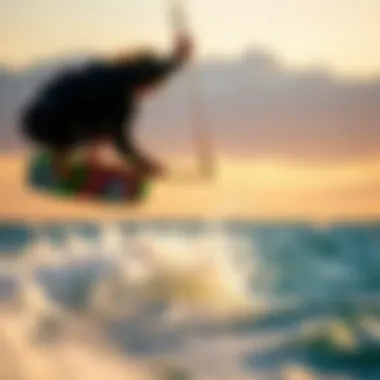
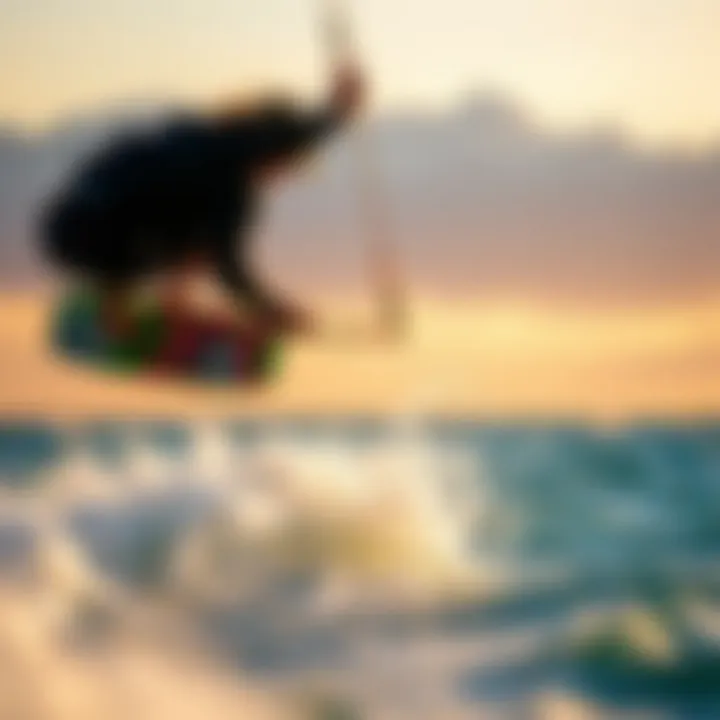
Pre-session planning is an essential practice for any kiteboarder. It’s not merely about the thrill of racing across the water; it’s fundamentally about safety and optimization. Before even setting foot on the sand, use wind maps to analyze the prevalent wind conditions. Essentially, you want to ask yourself:
- What are the wind speeds like today?
- How consistent is the wind direction?
- Are there sudden changes expected?
By answering these questions, kiteboarders can make educated decisions about when and where to launch. For instance, if a wind map indicates gusty conditions, consider adjusting your session to an earlier time when winds are steadier. This proactive approach not only increases the enjoyment of your outing but also reduces the likelihood of encountering unpredictable challenges.
"Proper planning prevents poor performance."
Utilizing wind maps effectively can ensure you have a positive kiteboarding experience, avoiding unnecessary risks.
Another key point in pre-session planning involves checking the recent weather trends. Wind maps often integrate historical data alongside real-time conditions, helping you predict how the day may unfold. If a local storm system is brewing, or if seasonal fluctuations are evident, you can avoid potential hazards before they arise.
Identifying Optimal Conditions
Once you’ve set the groundwork with your pre-session planning, the next step is identifying optimal conditions. This involves understanding not just what the maps indicate at a glance but diving deeper into what those conditions mean for your specific kiteboarding experience.
- Wind Speed: Understanding ideal wind speed for your skill level and gear is crucial. Generally, a speed of 12 to 25 knots is optimal for most kiteboarders, but this can differ based on individual preferences and equipment specs. Wind maps will give you a visual representation of varying speeds across different regions.
- Wind Direction: The effectiveness of your kiteboard session heavily leans on wind direction. If you’re familiar with local spots, knowing how the wind interacts with the geography can help you select the perfect launch site. For example, sideshore winds are typically considered optimal, offering more control and less risk of being blown away from the shore.
- Frequent Updates: Make it a habit to check wind maps periodically. The wind can be as fickle as a cat, shifting unexpectedly. Relying on real-time updates can inform last-minute decisions, allowing for adjustments in your plan. Tools like Windy or PredictWind can provide precise forecasts.
By proactively utilizing wind maps, kiteboarders can harness the full potential of favorable conditions, making each session not just enjoyable but also safe. Embrace the maps not as mere graphics but as guiding tools that empower your kiteboarding adventures.
Safety Considerations
Understanding the safety considerations associated with kiteboarding in Washington is crucial. Kiteboarding is no walk in the park. It's an exhilarating sport, but with the thrill comes some inherent risks, especially when one does not properly account for wind conditions. Misreading wind maps or failing to respect the variability of wind patterns can lead to accidents, injury, or worse. Therefore, having a solid grasp of safety measures is essential for every kiteboarder, novice or experienced.
Understanding Risks Associated with Wind
Wind, although the lifeblood of kiteboarding, carries risks that kiteboarders must be aware of. Variations in wind speed and direction can change rapidly, catching even the most attentive rider off guard. Here are some crucial risks to consider:
- Sudden Wind Gusts: Unexpected bursts of wind can lead to loss of control. If the gust is strong enough, it can pull a rider into the air unexpectedly, leading to falls or crashes.
- Changing Weather Conditions: A clear sky can mislead a kiteboarder about impending weather changes. Always pay attention to weather reports and be prepared to adjust plans.
- Wind Shadows: Objects in the environment, like buildings or trees, can create areas of calm—known as wind shadows. Approaching or flying into these zones can result in a sudden stall and crash.
- Offshore Winds: When the wind blows out to sea, it can push riders away from shore, creating potential situations where return becomes problematic.
"Wind can be a friend or foe—understanding its behavior is what separates a seasoned kiteboarder from a novice."
Every kiteboarder must take these risks seriously. Knowledge about local wind dynamics, patterns, and how to assess conditions on-site can make all the difference. It's not just about being aware of the wind but understanding how it interacts with one’s skill level, kite design, and body positioning.
Emergency Protocols
Having a set of emergency protocols can save lives. It’s not just about knowing how to ride the waves; it's also about being prepared if things go awry. Here are some protocols you should keep in mind:
- Emergency Equipment: Always have a quick-release mechanism and a safety leash. This equipment can prevent runaway kites that could pose a danger to you or others.
- Communication: Inform your friends or fellow kiteboarders about your intended plans for the day. If something goes wrong, knowing where you are can help others assist you quicker.
- VHF Radio or Mobile: In isolated areas, having a small communication device can facilitate distress calls if needed. Many kiteboarders opt to carry a waterproof phone case for emergencies.
- Knowledge of Local Shoals and Hazards: Each waterway has particular hazards. Familiarize yourself with local maps to avoid shallow waters, rocks, or debris that can be dangerous.
The reality is that kiteboarding can lead to unexpected adventures or unfortunate situations. By being proactive about safety and having emergency protocols in place, you can increase your chances of enjoying a fantastic day on the water while staying safe.
In summary, kiteboarding in Washington, with its unique wind conditions, demands special attention to safety. The wind’s behavior can make the difference between a thrilling session and a dire one. Taking the time to understand and prepare for the risks associated with wind and establishing solid emergency measures can empower kiteboarders to enjoy their passion while minimizing harm.
Technological Advances in Wind Mapping
Understanding and predicting wind patterns is crucial for kiteboarders, and the evolution of technology has fundamentally transformed how we access and interpret this information. Technological advances in wind mapping have made it easier for enthusiasts to plan their sessions effectively. With real-time data and sophisticated forecasting tools, kiteboarders can better gauge the conditions they’ll encounter on the water. This section delves into two remarkable facets of modern wind mapping: the utilization of satellite data and the emergence of real-time wind analysis tools.
Satellite Data Usage
Satellites play a pivotal role in collecting data that contributes to accurate wind mapping. They capture expansive views of the Earth’s atmosphere, which helps in tracking weather systems and understanding wind dynamics. With satellite data, kiteboarders can access high-resolution imagery showing wind patterns over large areas, which is essential for spotting the best locations and times for kiteboarding.
Key benefits of using satellite data include:
- Broad Coverage: Satellites can monitor remote areas that are typically hard to access. This is particularly advantageous for kiteboarders seeking less crowded spots away from urban environments.
- Real-Time Updates: Satellite data can refresh frequently, which means wind forecasts can be updated multiple times a day. This timely information aids kiteboarders in making informed decisions.
- Predictive Modeling: Modern satellites, coupled with meteorological models, can predict wind behavior several days in advance. This forecasting gives kiteboarders an edge in planning trips or events, ensuring favorable conditions.
Such data is often made available through various platforms, including government weather services and private weather companies, allowing users to effortlessly monitor wind conditions and make strategic choices for their adventures.
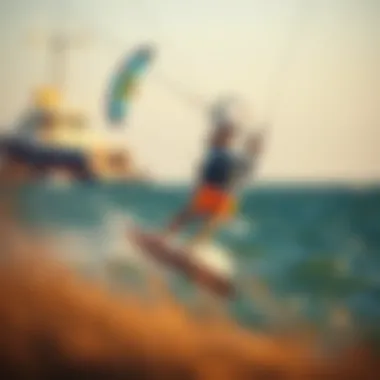
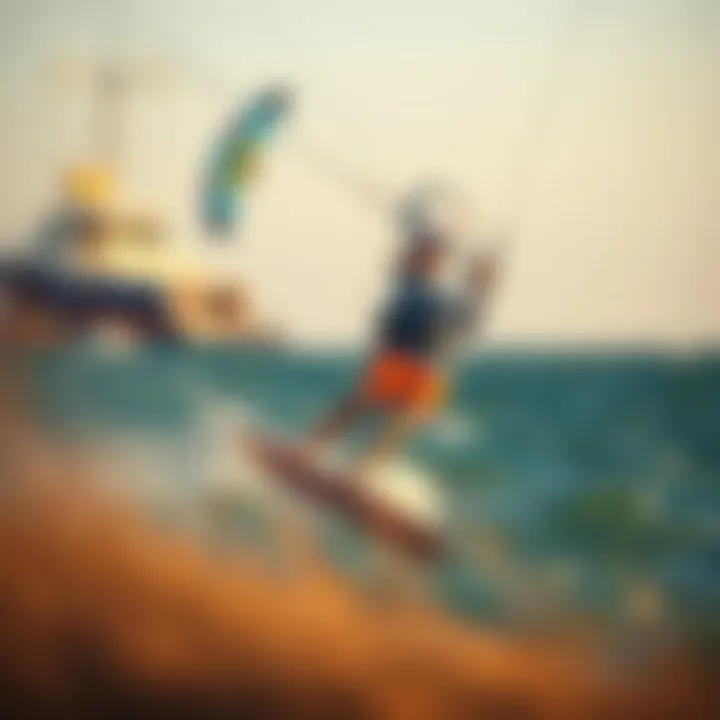
Real-time Wind Analysis Tools
Real-time wind analysis tools represent a significant leap forward in accessibility and precision. These tools offer immediate, detailed insights into wind conditions that can change rapidly. For kiteboarders, having access to this information at their fingertips can mean the difference between a thrilling session and an awe-inspiring disappointment.
Essential features of real-time wind analysis tools include:
- Interactive Maps: Modern platforms often provide interactive maps that display wind speed and direction over specific regions. Such visual representation helps users to easily identify windy versus calm areas, perfect for planning their kiteboarding outings.
- Live Updates: Many tools offer live wind updates that track changes in real-time. This feature allows kiteboarders to adapt to changing conditions, such as sudden gusts or shifts in wind direction.
- User-Generated Reports: Some tools integrate user-generated content, giving kiteboarders the chance to share their experiences and insights about local conditions. This collective information builds a community of informed adventurers.
Ultimately, the combination of satellite data usage and real-time analysis tools equips kiteboarders with the knowledge required to thrive in Washington’s diverse wind conditions. As technology continues to evolve, the ways in which these dynamics are mapped and understood will only improve. The better the resources available, the more effective kiteboarders can be in strategic planning and ensuring safety while enjoying the thrill of the sport.
"The winds can be unpredictable, but with the right tools, kiteboarders can sway with them instead of being blown away."
For more information on wind mapping technologies, consider checking these resources:
Environmental Impact of Kiteboarding
As kiteboarding gains traction among enthusiasts in Washington, understanding its environmental impact becomes crucial. Kiteboarding can be exhilarating, but its relationship with the environment requires deeper exploration. The lively winds that sustain riders also play a part in shaping the ecosystems around them. Knowing how kiteboarding affects these delicate environments informs better practices and decisions, ensuring future generations can enjoy both the sport and nature's beauty.
Impact on Local Ecosystems
Kiteboarding often takes place in areas like coastal shores, lakes, and rivers, ecosystems that host diverse species of plants and animals. When kiteboarders frequent these spots, they can inadvertently disturb wildlife. For instance, nesting birds might abandon their young due to the noise or presence of riders. Likewise, boat wakes can erode shorelines, affecting habitat stability for fish and other aquatic life.
The specific impacts vary from one location to another:
- Habitat Disruption: Approaching the shores can trample sensitive vegetation.
- Wildlife Disturbance: Birds and marine mammals might find their space invaded.
- Water Quality: Accumulation of gear debris in water bodies can affect habitats adversely.
Consider the serene environments of Lake Washington or the Columbia River Gorge; these areas are sanctuaries for many species. Carening through the air may seem harmless, but it’s vital to acknowledge the quiet lives of creatures living just below.
Sustainable Practices
To ensure that kiteboarding and environmental conservation go hand in hand, adopting sustainable practices is essential. Here are some strategies that every kiteboarder can embrace for a greener approach to this sporting pastime:
- Respect Wildlife: Be aware of nesting seasons and avoid sensitive areas.
- Leave No Trace: Clean up any equipment or waste before leaving a spot.
- Educate Fellow Riders: Share knowledge about local ecosystems and best practices.
- Travel Responsibly: Use designated launch sites to minimize habitat disruption.
- Support Local Conservation Efforts: Get involved or contribute to initiatives aimed at preserving natural habitats.
In the long run, practicing sustainability not only preserves the natural environment but elevates the experience for kiteboarders. The thrill of gliding on water and air should be a shared joy, passed on along with a healthy ecosystem.
"Kiteboarders can be the champions of environmental stewardship if they harness the wind with mindfulness and respect for nature."
Understanding the balance between fun and the effects on our surroundings empowers kiteboarders to be responsible athletes who appreciate both the waves and the wildlife. And lest we forget, the very winds that invigorate our sails deserve protection, too.
Future Trends in Wind Mapping and Kiteboarding
As kiteboarding continues to grow in popularity, understanding the latest trends in wind mapping is crucial for enthusiasts. Kiteboarders, from novices to seasoned pros, rely heavily on accurate and timely wind data for a successful and safe ride. The advancements envisaged in wind mapping technology promise not only to enhance the experience but also to broaden opportunities for kiteboarding across diverse locations in Washington.
Emerging Technologies
The realm of wind mapping is on the cusp of significant transformation, driven largely by innovative technologies. One key player in this evolution is drone technology. Drones equipped with sensors and cameras are capable of capturing real-time wind data across various terrains. This can vastly increase the accuracy of local wind assessments. Unlike traditional methods, drones can fly at different altitudes and cover extensive areas rapidly, offering a more dynamic picture of wind conditions.
Moreover, mobile apps are stepping up in functionality and user experience. Applications that visualize wind patterns in user-friendly interfaces are becoming increasingly popular. These apps leverage satellites and ground stations to deliver live updates straight to the kiteboarder's pocket. With features displaying wind speed, direction, and even water conditions, these tools help adventurers make quick and informed decisions.
Another noteworthy trend is the rise of machine learning algorithms that analyze historical data to predict future wind patterns. This predictive capability will allow kiteboarders to plan their excursions more effectively, aligning their activities with favorable conditions. Access to this data will empower users to create better strategies for their kiteboarding sessions.
Changing Climate Patterns
As we continue to grapple with the effects of climate change, understanding how these shifts influence wind patterns is essential for kiteboarders. Historical data shows that climate fluctuations can lead to erratic weather conditions, affecting not only wind speeds but also the predictability. For instance, warmer ocean temperatures can alter wind directions and intensities, something kiteboarders need to keep in mind when planning their outings.
Monitoring these changes goes beyond just kiteboarding. The adaptations practitioners make can also resonate broadly with local ecosystems. Kiteboarders who are aware of shifting wind patterns can take proactive steps in minimizing their environmental impact, thereby promoting sustainable practices. Efforts such as respecting wildlife habitats and being conscious of pollution are increasingly vital in an era where our adventures can intersect with ecological balance.
"Understanding the interplay between climate changes and wind patterns isn't just about enjoying a good session; it's paramount in ensuring the sustainability of kiteboarding as a sport for future generations."


